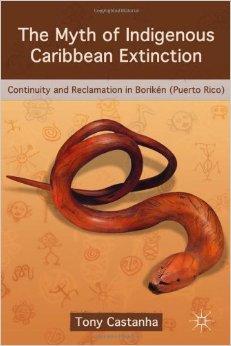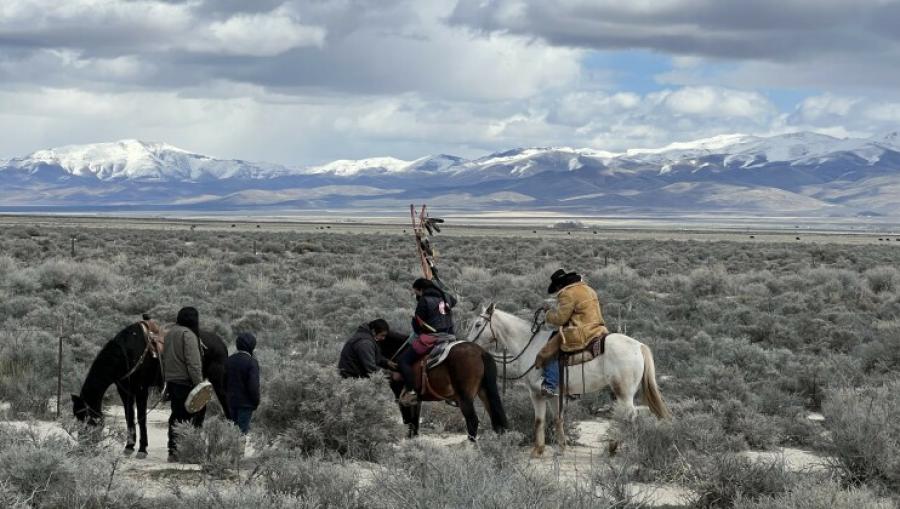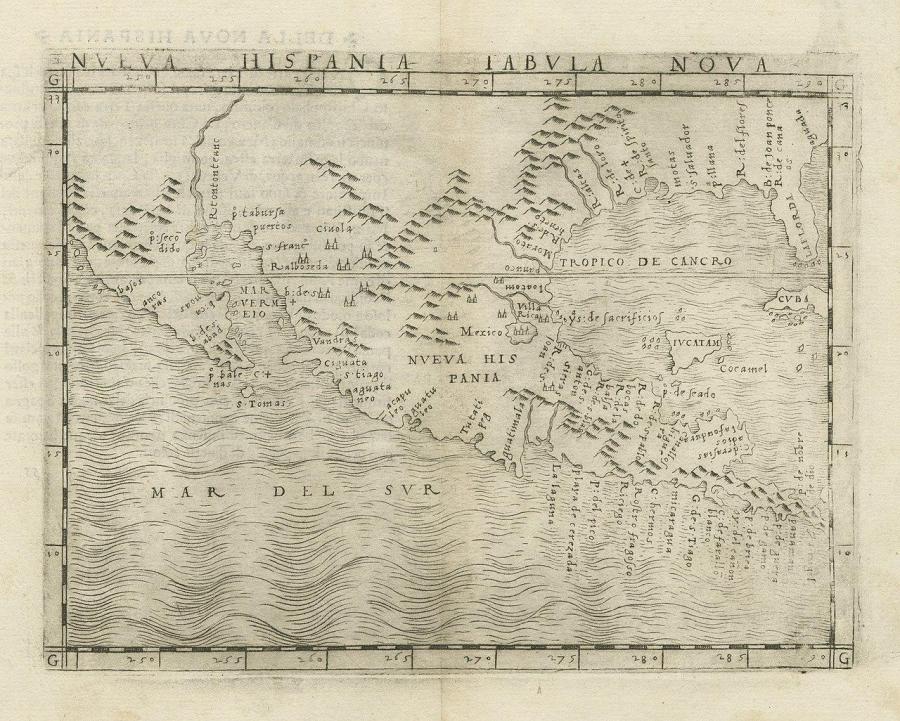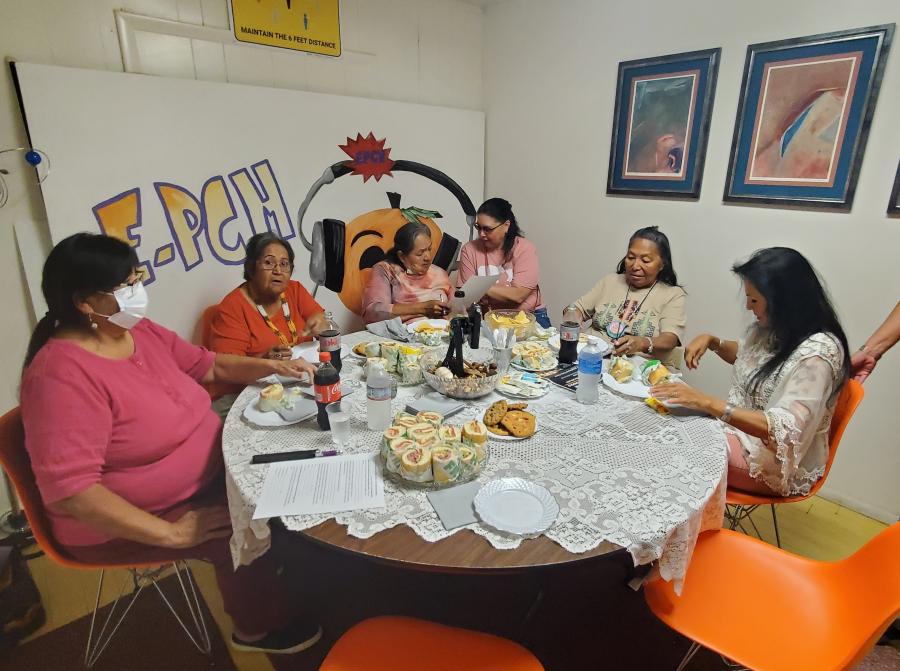
Cultural Survival Quarterly contributing arts editor Phoebe Farris recently spoke with Tony Castanha, author of The Myth of Indigenous Caribbean Extinction: Continuity And Reclamation in Boriken (Puerto Rico) [Palgrave Macmillian, a division of St.Martin’s Press, New York, NY, 2011] about his recent work.
Phoebe Farris: What initially inspired you to conduct this research that offers an alternative perspective on the history of Indigenous Peoples in the Caribbean, especially Puerto Rico, people that mainstream history books claim are extinct?
Tony Castanha: Guatiao, Phoebe. My research was initially inspired by my own ancestors or family on my mother’s side, who emigrated from Borikén (Puerto Rico) to Hawai‛i in 1901 as sugar plantation laborers. They were recruited by the Hawaiian Sugar Planters’ Association after the hurricane San Ciriaco devastated the southwestern region of the island. The members of my family were Indian people, who along with many of the over 5,000 people who went to Hawai‛i, referred to themselves as “Jíbaro” or “Boricua Indian.” They were people of the land, yuca and coffee farmers. This history inspired me to do further research because I knew the claim of our peoples’ “extinction” and other misrepresentations were not possible. From 1998 to 2008, I made numerous trips to Borikén to conduct research that is documented in my doctoral dissertation (2004) and published book (2011). I now live in Puerto Rico and have constantly sought out the truth to refute mainstream Caribbean academic narratives that misrepresent the Indigenous Peoples of the region.
PF: Very early in your book you mention that the portrait of Puerto Ricans as a mixture of Indian, Spanish, and African eliminated the indigenous presence by the end of the 18th century and that after 1799 the category of Indian was removed from the census. But in the United States a person can be ¼ or even less and still be recognized by the Federal government, tribal enrollment, and personal choice as Native American. Why does Puerto Rico have such different “rules” or determining factors to classify people as American Indian/Indigenous?
TC: For one, even in the United States, such rules and laws were not established in the late 1700s. Those in power in Puerto Rico could manipulate the rules to their advantage (guess some things never change). When the governor was given the opportunity of “fixing ethnic origins,” he did so to quell the “masses,” who were mostly Indigenous peoples, to transform them into a national symbol to be exploited and disauthorized as a living entity. This paradigm continues to inform mainstream Puerto Rican society. So unlike in the U.S., Native American recognition has been negligible.
PF: The Myth of Caribbean Extinction discusses the global Indigenous movement that began in the 60’s and 80’s and led to the revitalization of native pride and the right to reconnect with one’s traditional past. During the 60’s, 70’s. and the 1992 quincentennial was there contact between Indigenous people in Puerto Rico, other Caribbean countries and Native American activists in the United States?
TC: With the considerable Puerto Rican emigration to the U.S. in the 1940s and 1950s, some were definitely inspired by the American Indian Movement of the 60’s and 70’s. Some returned to Puerto Rico in the subsequent years to educate and help inspire the modern movement and native continuity. This happened in Hawai‛i too in terms of the impetus for the indigenous movement there by Hawaiian students who were in the U.S.
There has been substantial intercultural contact between Caribbean islands over the past two or three decades in relation to indigenous identity and heightened awareness. This has resulted in the formation of a number of “pan-Caribbean” and regional indigenous organizations such as the Caribbean Organization of Indigenous Peoples (COIP). There has also been networking between certain North American native organizations and Caribbean indigenous bodies. Some of this information is documented in Forte’s, ed., excellent anthology titled, Indigenous Resurgence in the Contemporary Caribbean: Amerindian Survival and Revival (2006).
PF: How involved were Puerto Ricans living in New York and Florida with these movements? Puerto Ricans living in NY and FL have easy access to the island due to numerous relatively inexpensive flights. Was it difficult for Puerto Ricans like you and others who live in Hawaii to become immersed in this native Borikén/Puerto Rico resurgence movement?
TC: Most Puerto Ricans who were active and living in the U.S. in the 1960s and 1970s were more connected with the nationalist and independence movements on the island. There was a strong push for independence in the 1970s, which, as we know, resulted in the jailing of quite a number of Puerto Rican activists in U.S. prisons. Both Oscar López Rivera and Carlos Alberto Torres are still being unjustly imprisoned with increased calls for their release. New York City and especially Chicago were hotbeds of this activism. While there is apparently no direct connection between these movements and the Indigenous resurgence, the quest for freedom and independence is historically and traditionally a very strong attribute in Borikén dating back at least to the arrival of the Spanish Christians.
Yes, in Hawai‛i we were very removed from the “action” taking place in the states and in Puerto Rico. Our connection, for the few who were active, was to the Hawaiian movement. I did not get involved in the Caribbean movement until the mid-1990s. While I knew of my native identity, it wasn’t until I read the Introduction of my cousin’s doctoral thesis on our family’s emigration to Hawai‛i that I was able to connect the cultural dots of our history and identity as a people.
PF: Please define the Puerto Rican word Jibaro and the Cuban word Guajiro for our readers. Until I read your book I thought both names identified “peasants” from rural areas as opposed to wealthy rural land owners. I did not realize there was an underlying racial or ethnic component to the classification.
TC: The names Jíbaro and Guajiro are the same word. “Peasant” is a code word for “native” since everyone thought the Indigenous Peoples were “extinct.” The word was debased and given a negative connotation just like the name “Kanaka” in Hawai‛i was used in a derogatory way to describe the Indigenous Peoples there. The name Jíbaro is derived from the word “Canibaro” or “Can’chib’al’o,” which traditionally refers to the northwestern part of the island called “Caniba.” The prefix “can” means snake or any type of reptile in the Indian language, and “chib’al’o” denotes decent from the male line or from the first ancestor (Báez Santiago and Martínez Prieto 2008). So the name “Jíbaro” basically refers to the first ancestor of the island from whom all people descend from.
PF: Since “the personal is political” do you care to share with readers any aspects of your personal life such as why your family and others migrated from Puerto Rico to Hawaii and what impact migration had on their identities as Puerto Rican in general and specifically for those who identify as indigenous? Are both your parents Puerto Rican? Was or is there much intermarriage between indigenous Hawaiians and Puerto Rican immigrants?
TC: I partially reference this in the first question. The hurricane San Ciriaco took the lives of over 3,000 people in Puerto Rico. It was probably the most devastating storm recorded in the Caribbean (and elsewhere?) up until that time. This natural disaster brought recruiters from Hawai‛i who were politically astute and only concerned about profit. The condition of the Boricua was such that they should probably have never embarked on such a lengthy and grueling voyage but were basically coerced into doing so. They were caught up in the global economic labor market of the time. Certainly their identities would shift over time with living in a very new society. For one, the nationalist term “Puerto Rican” would be more widely employed in order to be understood by those who were foreign to them. But among themselves they were still Jíbaro or Boricua people.
I don’t believe there was much intermarriage early on between Kanaka Maoli and Jíbaro immigrants. However, intermarriage over time (second and third generations) became more common. A lot of Native Hawaiians today are of Puerto Rican descent and a number of Kanaka Maoli activists are also Boricua.
PF: Is there currently dialogue between Cuban guarijos and Puerto Rican jibaros as far as cultural revitalization? Was there historical collaboration among indigenous peoples in both islands during the armed resistance in the 1500’s-1800’s? Have you collaborated with the scholar Jose Barreiro whose research focuses on Cuban Taino communities?
TC: Yes, there is dialogue between Jíbaro and Guajiro, especially over the internet. Native descendants from the Dominican Republic and Jamaica are also taking part in ongoing conversations and research on Caribbean indigeneity. Unlike the collaboration and resistance to American imperialism by Cubans and Boricua in the late 1800s, I do not know of direct collaboration between the two islands in the early centuries. I would imagine there was as trade and navigation had been a prevalent pre-European undertaking.
I have met, interviewed and definitely know of the work of José Barreiro. He has been doing very important ethnological research with Guajiro people in eastern Cuba. My research in Borikén parallels his in terms of collaboration and working in living communities. One point of difference between us concerns ascription. Ironically, the people of the eastern mountains identity as Guajiro, yet Barreiro (who himself has identified as “guajiro”) continues to gloss the popularized term “Taíno” as their name. This is despite the lack of concrete evidence to suggest that the indigenous peoples of the northern Antilles ever referred to themselves by that name. The name “Taíno” simply has not survived in native communities, while the names “Jíbaro” and “Guajiro” have. I do not wish to empower the word by using it, except in quotations or quoted material when necessary.
PF: The Myth of Caribbean Extinction lists many indigenous names for foods, places, and objects throughout the Caribbean. You also discuss the jibaro accent and the jinaro use of older Spanish words from the time of conquest, words not used anymore by most contemporary Spanish speakers. This seems similar to Haitian Creole as opposed to European French, Papiement which is a mixture of Dutch, west African, and indigenous words spoken in Suriname and Aruba, and Jamaican “patois” for lack of a better name. Is there currently any language reclamation project in Puerto Rico or other Caribbean countries similar to what is happening in Native American tribes in the United States?
TC: The Indian accent I mention for Spanish words is still commonly utilized in the mountain regions. In terms of language recovery, there have been “bits and pieces” of native language recovery and restoration in Puerto Rico and the Caribbean in general. I do not know of any effective projects, but there may be and could be in the future. Now that I am here in Borikén, I am much closer to the “action” and will be keener to these issues.
PF: There is a lot of confusion and scholarly debate concerning the tribal names Taíno, Arawak, and Carib to identify Indigenous Peoples in the Caribbean and parts of South America. Can you briefly clarify the distinctions among these three populations, explaining their historical origins and where most of their contemporary descendants now live?
TC: There has been considerable controversy about naming and the division of Caribbean peoples. European imperial powers were keen to divide the people they encountered out of their own moral, political, and economic interests. I believe this was the case in the Antilles as eternalized in the largely imagined ethnical and cultural rift created between the “peaceful Arawaks” and “man-eating Caribs”. I use the words “iIndigenous Caribbean” or Carib as general names for the Indigenous Peoples of the “Caribbean” or “Antillean” region. Other than slightly varying socioeconomic conditions depending largely on island topography, those present in the region were essentially of the same family of people. Most scholars realize that the name “Taino”, like the word “Arawak” was not used by Indigenous Peoples as a term of self-ascription. The word was used as an adjectival, taken from the word “nitayno”, which related to one’s rank within society. The name Carib or Caribe emerged from "Jibaro" (Canibaro), which in turn, is derived from the place name, Caniba. The regional Caribbean, was further taken from the people who were living there.
I am sure there are Arawak people living in the Antilles, but I do not know of any “groups” per se living here. They are in South America. The word “Aruaca” or “Arawak”, in its numerous forms, was first recorded by the Spanish in 1520 when referring to a South American province and evidently projected onto the people of parts of Trinidad, the lower Orinoco region, and coastal Guianas. I believe the Indigenous Peoples of the region are of Carib descent, whose ancestry originated in the Caribbean with cultural influences predominately from Mesomamerica.
But the origins of all these terms is too complex to discuss in an interview so for further clarity readers need to read the book.
PF: According to your research 61% of Puerto Ricans tested positive for Indigenous ancestry in a recent DNA study conducted by Juan Martinez-Cruzado and colleagues at the University of Puerto Rico-Mayaguez. These tests were based on Mitochrondial DNA inherited from the female line only. Why didn’t the testing also include the male line since some Indigenous people may be descended from Native men who intermarried women from other ethnic/racial backgrounds? If additional DNA testing is done to include the male line do you think the percentage may be higher? Of the 61% who tested positive for Native ancestry what was the percentage range, such as ½, ¼, 1/8 indigenous “blood”?
TC: I don’t know why the study did not include males. My guess is the type of testing technique utilized only measures females. And since there is a strong known about female survival, Martínez-Cruzado may have went with that technique. Yes, some people are definitely descended from the male line, and know of their genealogy. Thus, this would increase the percentage of native descendants on the island. I do not know of the percentage range or if the tests even deciphered this, but one of my interviewees did say that his father tested “100 percent” – “indio completo” (92).
PF: Since Puerto Rico is an American possession or colony, depending on your politics and Puerto Ricans are U.S. citizens, are Indigenous Puerto Ricans entitled to receive some of the Federal benefits mainland Native Americans are entitled to such as Indian Health Services for example? Are Indigenous Puerto Ricans seeking some type of Federal or state recognition? Are Indigenous Puerto Ricans seeking reparations from Spain for broken treaties from the colonial era?
TC: They are probably “entitled” to because the indigenous peoples continue to be oppressed under the U.S. federal arm. As you likely know, Puerto Ricans did not want to be American citizens. Yet, they’ve used this status to their advantage as a sort of “tradeoff” for American possession and use of the island/s. From my contacts, there are no indigenous groups or peoples seeking federal recognition in Puerto Rico. The people know who they are and don’t see the point in being recognized, which could do more harm than good. The issue at the state level seems to be more politically complicated, but the sentiment is similar.
PF: Lastly, is there anything else you would like to share with our readers about your book, current research projects, etc.?
TC: All I have to say is that my work is not merely a theoretical exercise. I have made sure to be “on the ground” with the people and active in communities, attempting to bring voice to those who have not been heard. My drive and commitment have been interestingly motivated by my ancestors, who were a part of this silencing, and through spirit. I have come “full circle” in returning to my native homeland. It has truly been quite a voyage.
PF: Thank you Tony for enlightening me and our readers about indigenous continuity and reclamation in Boriken (Puerto Rico).
TC: Muchas gracias.



